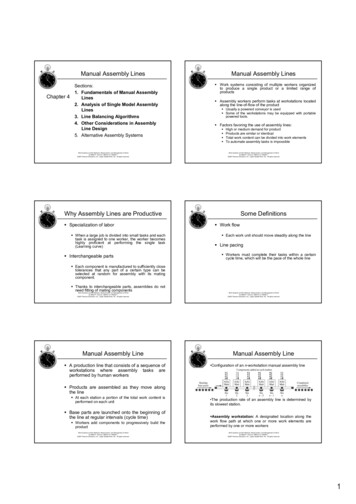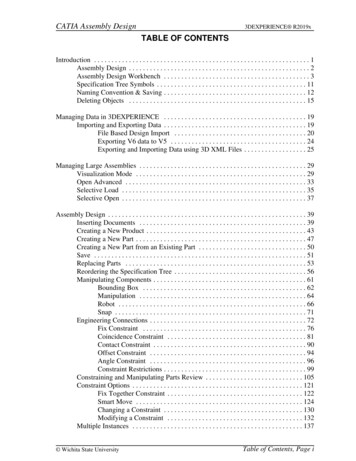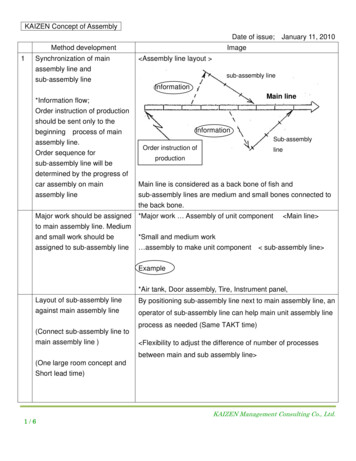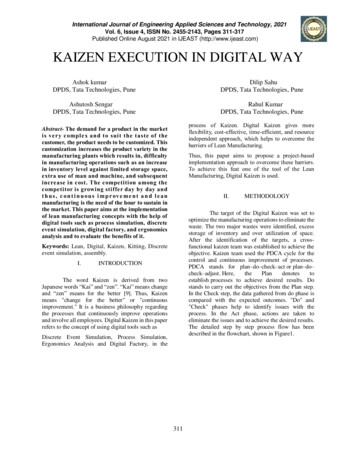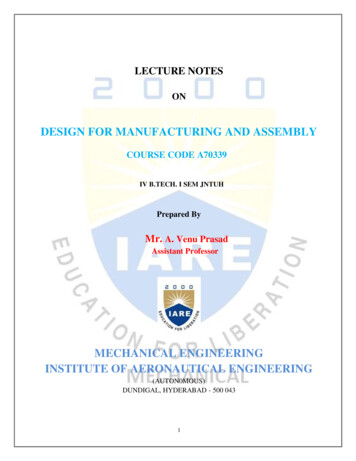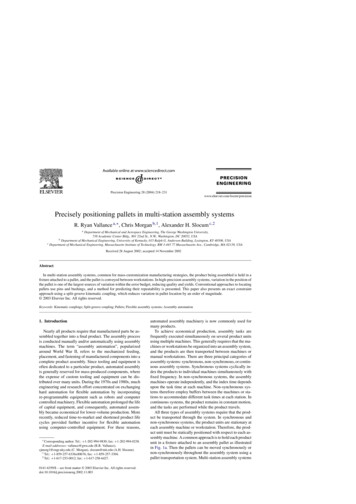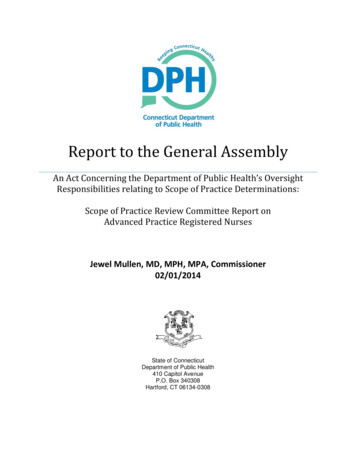
Transcription
Report to the General AssemblyAn Act Concerning the Department of Public Health’s OversightResponsibilities relating to Scope of Practice Determinations:Scope of Practice Review Committee Report onAdvanced Practice Registered NursesJewel Mullen, MD, MPH, MPA, Commissioner02/01/2014State of ConnecticutDepartment of Public Health410 Capitol AvenueP.O. Box 340308Hartford, CT 06134-0308
State of ConnecticutDepartment of Public HealthReport to the General AssemblyAn Act Concerning the Department of Public Health’s OversightResponsibilities relating to Scope of Practice Determinations for Health CareProfessions: Advanced Practice Registered NursesTable of ContentsExecutive Summary. 3Background . 6Scope of Practice Request. 7Impact Statements and Responses to Impact Statements . 7Scope of Practice Review Committee Membership . 8Scope of Practice Review Committee Evaluation of Request . 9Health & Safety Benefits . 9Access to Health care . 10Relevant Laws Governing the Profession . 15Education, Training and Applicable Certification Requirements . 16Summary of Known Scope of Practice Changes . 20Impact on Existing Relationships within the Health care Delivery System . 20Economic Impact . 21Regional and National Trends . 22Other Health care Professions that May be Impacted by the Request. 23Description of How the Requests Relates to the Profession's Ability toPractice to the Full Extent of the Profession's Education and Training . 23Findings and Conclusions . 24P a g e 2
Executive SummaryIn accordance with Connecticut General Statutes, Sections 19a-16d through 19a-16f, inclusive, theConnecticut Advanced Practice Registered Nurse Society (CTAPRNS) submitted a scope of practicerequest to the Department of Public Health to eliminate the requirement for the mandatorycollaborative practice agreement with a physician. In doing so, one of their goals is to allow licensedadvanced practice registered nurses the flexibility to establish independent practices while continuing tocollaborate with a variety of health care providers, including physicians. CTAPRNS asserts that themandatory collaborative agreement serves no public safety or quality assurance purpose, and presentssignificant negative impacts on health care cost and access to care.In 2010, the Institute of Medicine (IOM) issued its report entitled “The Future of Nursing: LeadingChange, Advancing Health.” This report included specific recommendations to Congress, statelegislatures, the Centers for Medicare and Medicaid Services, the Federal Trade Commission and othersaimed at addressing several key messages including, but not limited to, the concept that nurses shouldpractice to the full extent of their education and training. Specific recommendations relevant to thisscope of practice discussion include: Remove scope of practice barriersAdvanced practice registered nurses should be able to practice to the full extent of theireducation and training Expand opportunities for nurses to lead and diffuse collaborative improvement effortsPrivate and public funders, health care organizations, nursing education programs and nursingassociations should expand opportunities for nurses to lead and manage collaborative effortswith physicians and other members of the health care team to conduct research and to redesignand improve practice environments and health systems. These organizations should alsoprovide opportunities for nurses to diffuse successful practices. Implement nurse residency programsState Boards of Nursing, accrediting bodies, the federal government and health careorganizations should take action to support nurses’ completion of a transition-to-practiceprogram (nurse residency) after they have completed a pre-licensure or advanced practicedegree program or when they are transitioning into new clinical practice areas.The scope of practice review committee reviewed and evaluated all of the information provided inCTAPRNS’ scope of practice request as well as additional information that was requested and providedas a result of committee discussions. In reviewing and evaluating the information presented, the scopeof practice committee focused on assessing any public health and safety risks associated with therequest, whether the request may enhance access to quality and affordable health care and whetherthe request enhances the ability of the profession to practice to the full extent of the profession’seducation and training.P a g e 3
The Connecticut Advanced Practice Registered Nurse Society (CTAPRNS) provided documentation fromnumerous studies demonstrating that advanced practice registered nurses provide safe, high-qualitycare. These studies found that APRNs produce patient outcomes that are comparable to, or in someinstances exceed, those of physicians in areas such as patient health status and functional status, use ofemergency departments and patient satisfaction. Additionally, evidence provided from practiceexperience in other states where there is no requirement for a physician collaborative agreementdemonstrates that removal of the agreement creates an environment in which APRNs are able toexpand current practice and explore other options for delivering primary care services.The documentation reviewed by the committee supports that an APRN’s ability to practiceindependently should be directly linked to the APRN’s education, training and maintenance ofcompetency through national board certification. Several committee members expressed significantconcerns with the proposal to remove the mandatory collaborative agreement, including, but notlimited to, issues related to what they believe to be deficiencies in the education, training andcertification requirements for APRNs when compared to those required for physicians and physicianassistants. There was however no evidence or data provided as part of the scope of practice reviewprocess to validate that removing the mandatory collaborative agreement would alter APRN patientcare or place patients at risk, or that that patients are at risk or care has deteriorated in other stateswhere there is no required collaborative practice agreement. The committee also discussed theimportance of mentoring newly licensed and certified health care providers, whether they are APRNs,physicians or other practitioners, to the practice environment and requiring some type of residency orother “transition-to-practice” program to provide a mechanism for the practitioner to optimize clinicalcompetency in the practice environment before they practice independently. Working towardestablishing residency or “transition-to-practice” programs for nurses, after they have completedadvanced practice degree programs or when they are transitioning into new clinical practice areas,aligns with the recommendations included in the 2010 Institute of Medicine report on the future ofnursing. In states where the requirement for the mandatory collaborative agreement has already beeneliminated and where there is documentation demonstrating that patient outcomes have beenfavorable, residency programs have not been established.Documentation of practice experience in other states where there is no requirement for a physiciancollaborative agreement supports removing barriers that negatively impact an APRN’s ability to practiceto the full extent of her or her education and training, and enhances access to quality and affordablehealth care. The evidence provided by CTAPRNS in support of their scope of practice request alsorevealed that there can be substantial risks for the APRN as well as his or her patients associated withestablishing a private practice with the current requirement for maintaining a written collaborativepractice agreement. For example, if the collaborating physician abruptly terminates the collaborativeagreement for any reason, such as death or retirement, the APRN is placed in an untenable dilemma ofpracticing without legal authority despite the professional ethical requirement not to abandon patients.Some of these barriers have been mitigated in settings such as group practices, hospitals or other largehealth systems. Physicians who practice in settings such as group practices, hospitals or other largeP a g e 4
health systems where physicians, APRNs, physician assistants and others work together as a team,indicated that it is not the mandatory collaborative agreement or “piece of paper” that drives theircollaborative practice with APRNs but rather the mutually respectful, educational and responsible teamrelationship that develops over time working together and the need for collegial interactions to ensurepatients’ health care needs are being met. Committee members agree that a team approach toproviding care that includes multidisciplinary collaboration is critical. Although the mandatory physiciancollaborative agreement does not in and of itself necessarily limit an APRN’s ability to practice to the fullextent of his or her education and training, evidence was provided during the scope of practice reviewprocess to demonstrate that the required collaborative agreement has become a barrier to practice formany APRNs and that eliminating barriers enhances access to quality and affordable health care.In 2012 the National Governors Association (NGA) issued a paper titled “The Role of Nurse Practitionersin Meeting increasing Demands for Primary Care.” Findings from this report include: Nurse practitioners may be able to mitigate current and projected shortages of primary careservices. Existing research suggests that nurse practitioners can perform a subset of primary careservices as well as or better than physicians. Expanded utilization of nurse practitioners has the potential to increase access to health care,particularly in historically underserved areas.The NGA report also indicates that none of the studies included in their literature review raised concernsabout the quality of care offered by nurse practitioners and that most of the studies they evaluatedshowed that care provided by nurse practitioners is comparable to physician-provided care on severalprocess and outcome measures. The report indicated that the evaluated studies suggest that nursepractitioners may provide improved access to care. Evidence provided in support of the CTAPRNS’scope of practice request also demonstrates improvements in access to care in states where there is norequirement for a physician collaborative agreement. There was no documentation or evidenceprovided to refute these findings.Documentation that was provided in support of their request to eliminate the mandatory collaborativeagreement substantiates that in other states where there is no mandatory collaborative agreementthere have been cost savings including lower drug costs, lower per-patient costs, lower visit costs andlower costs associated with lower rates of emergency department referrals. No specific data relative tocosts in Connecticut is available. It was suggested that if a proposal to eliminate the requirement for acollaborative agreement move forward, data regarding any costs savings should be tracked.Limitations associated with the APRN scope of practice and the requirement for a collaborativeagreement are not the only barriers that impact an APRN’s ability to practice to the full extent of his orher education and training. Other Federal and state laws and regulations and/or accreditation standardsor other rules governing areas including, but not limited to, reimbursement, admitting privileges,ordering and evaluating tests, and frequency of APRN and physician visits, also restrict APRNs frompracticing to the full extent of their education and training. The scope of practice committeeP a g e 5
acknowledged the existence of these additional barriers however, they are outside the purview of thisscope of practice review process. Although eliminating the mandatory collaborative agreement wouldenhance an APRN’s ability to practice to the full extent of his or her education and training, it would notremove these additional barriers.BackgroundPublic Act 11-209, An Act Concerning the Department of Public Health’s Oversight ResponsibilitiesRelating to Scope of Practice Determinations for Health Care Professions, established a process for thesubmission and review of requests from health care professions seeking to revise or establish a scope ofpractice prior to consideration by the General Assembly. Under the provisions of Sections 19a-16dthrough 19a-16f, inclusive, of the Connecticut General Statutes, persons or entities acting on behalf of ahealth care profession that may be directly impacted by a scope of practice request may submit awritten impact statement to the Department of Public Health. The Commissioner of Public Health shall,within available appropriations, establish and appoint members to a scope of practice review committeefor each timely scope of practice request received by the Department. Committees shall consist of thefollowing members:1. Two members recommended by the requestor to represent the health care professionmaking the scope of practice request;2. Two members recommended by each person or entity that has submitted a written impactstatement, to represent the health care profession(s) directly impacted by the scope ofpractice request; and3. The Commissioner of Public Health or the commissioner’s designee, who shall serve as anex-officio, non-voting member and chairperson of the committee.The Commissioner of Public Health was also authorized to expand the membership of the committee toinclude other representatives from other related fields if it was deemed beneficial to a resolution of theissues presented.Scope of practice review committees shall review and evaluate the scope of practice request,subsequent written responses to the request and any other information the committee deems relevantto the scope of practice request. Such review and evaluation shall include, but not be limited to, anassessment of any public health and safety risks that may be associated with the request, whether therequest may enhance access to quality and affordable health care and whether the request enhancesthe ability of the profession to practice to the full extent of the profession’s education and training.Upon concluding its review and evaluation of the scope of practice request, the committee shall provideits findings to the joint standing committee of the General Assembly having cognizance of mattersrelating to public health. The Department of Public Health (DPH) is responsible for receiving requestsand for establishing and providing support to the review committees, within available appropriations.P a g e 6
Scope of Practice RequestThe Connecticut Advanced Practice Registered Nurse Society (CTAPRNS) submitted a scope of practicerequest to eliminate the requirement for the mandatory collaborative practice agreement with aphysician. In doing so, their goals include allowing licensed Advanced Practice Registered Nurses theflexibility to establish independent practices while continuing to collaborate with a variety of health careproviders, including physicians. CTAPRNS anticipates that eliminating the requirement for thecollaborative agreement will have no impact on collegial consultation and collaboration among healthcare providers, specialty referrals and other expected professional practices, and that patient carewould continue without interruption or change.Impact Statements and Responses to Impact StatementsWritten impact statements in response to the scope of practice request submitted by CTAPRNS werereceived from several individuals and organizations: AARP American Psychiatric Nurses Association CT Region Community Health Center, Inc. Connecticut Academy of Family Practitioners Connecticut Academy of Physician Assistants Connecticut Association of Nurse Anesthetists Connecticut Chapter of the National Association of Pediatric Nurses and Practitioners Connecticut Coalition of Advanced Practice Nurses Connecticut ENT Society Connecticut Dermatology & Dermatologic Surgery Society Connecticut Urology Society Connecticut Hospital Association Connecticut Nurses Association Connecticut Psychiatric Society Connecticut Society of Eye Physicians Connecticut Society of Radiologic Technologists Connecticut State Medical Society Erin McCarthyP a g e 7
Danielle Morgan, APRN Henry Schneiderman, M.D. Edward Volpintesta, MDSeveral of these individuals and organizations are supportive of eliminating the requirement for themandatory collaborative practice agreement. While the other organizations indicated a willingness todiscuss how barriers to obtaining and maintaining the collaborative agreement can be addressed, theyare not supportive of an independent practice model. All of the impact statements that were receivedby the Department of Public Health in accordance with the statutorily mandated submission date areincluded in the Appendix. CTAPRNS submitted written responses to the impact statements, which werereviewed by the scope of practice review committee and are also included in the Appendix.Scope of Practice Review Committee MembershipIn accordance with the provisions of Connecticut General Statutes, Section 19a-16e, a scope of practicereview committee was established to review and evaluate the scope of practice request submitted bythe CTAPRNS. The committee established for this scope of practice request included representationfrom:1. AARP2. American Psychiatric Nurses Association CT Region3. Community Health Center, Inc.4. Connecticut Academy of Family Practitioners5. Connecticut Academy of Physician Assistants6. Connecticut Advanced Practice Registered Nurse Society7. Connecticut Association of Nurse Anesthetists8. Connecticut Chapter of the National Association of Pediatric Nurses and Practitioners9. Connecticut Coalition of Advanced Practice Nurses10. Connecticut ENT Society11. Connecticut Dermatology & Dermatologic Surgery Society12. Connecticut Urology Society13. Connecticut Hospital Association14. Connecticut Nurses Association15. Connecticut Psychiatric Society16. Connecticut Society of Eye Physicians17. Connecticut Society of Radiologic Technologists18. Connecticut State Medical SocietyP a g e 8
19. Erin McCarthy20. Danielle Morgan, APRN21. Henry Schneiderman, M.D.22. Edward Volpintesta, MD; and23. The Commissioner of Public Health’s designee (chairperson and ex-officio, non-votingmember).Scope of Practice Review Committee Evaluation of RequestCTAPRNS’s scope of practice request included all of the required elements identified in ConnecticutGeneral Statutes Section 19a-16d. Relevant information is outlined below.Health & Safety BenefitsThe Connecticut Advanced Practice Registered Nurse Society (CTAPRNS) provided documentation fromnumerous studies demonstrating that advanced practice registered nurses provide safe, high-qualitycare. These studies found that APRNs produce patient outcomes that are comparable to, or in someinstances exceed, those of physicians in relation to patient health status and functional status, use ofemergency departments and patient satisfaction. This evidence provided by CTAPRNS in support oftheir request concluded that APRN care is equivalent to physicians in the following areas: Patient satisfaction with care and provider; Functional status; Self-reported perceptions of health status; Management of blood glucose; Management of hypertension; Management of serum lipids; Emergency department visits; Hospitalization; and Mortality.CTAPRNS and other committee members also identified multiple potential benefits of allowing APRNs topractice to the full extent of their education and training without requiring a physician collaborativeagreement. APRNs are known for their emphasis on holistic patient care, prevention, health promotionand living well with chronic conditions. Evidence provided from practice experience in other stateswhere there is no requirement for a physician collaborative agreement demonstrates that removal ofthe agreement creates an environment in which APRNs are able to expand current practice and exploreP a g e 9
other options for delivering primary care services. Additional benefits in these other states haveincluded: Increased access to health care which will become increasingly important as the number ofinsured individuals and families is expected to increase with further implementation of theAffordable Care Act; Increased choice for patients concerning health care providers; Ability for APRNs to spend additional time with patients; Decreased costs over time related to increased disease prevention and health promotionactivities; and Reduction in duplication of services.Although many of the representatives from the physician organizations participating on the scope ofpractice review committee indicated that they are extremely uncomfortable with the proposal toremove the mandatory collaborative agreement and have identified strong concerns regarding publichealth and safety, there was no substantive evidence or data provided to demonstrate that patient carewould be at risk if the collaborative agreement was removed for APRNs who have received adequateeducation and training as well as mentoring in the practice environment. They caution that withoutcarefully evaluating each of the studies provided in support of the CTAPRNS’ request as well as anystudies to the contrary, conclusions regarding health safety and benefits should not be drawn. It shouldbe noted that there were no contrary studies provided to the committee for review.In The Physicians Foundation November 2012 report titled “Accept No Substitute: A Report on Scope ofPractice,” the authors specifically note that there is a lack of evidence and few, if any, studies availableto “refute the growing body of research presented by non-physicians and their advocates that tends toshow that their clinical outcomes are at least as good as those of physicians.” The report also recognizesthat despite methodological flaws and limitations identified by physicians in reviewing the many studiesregarding the safe practice of APRNs, conclusions have been drawn that nurse practitioners can provideprimary care as well as physicians. The report indicates that it is possible that these conclusions mayhave been based on the cumulative weight of a substantial number of studies however one study citedin this report does state that “the findings suggest that nurses and doctors generate similar healthoutcomes for patients, at least in the short-term, over the range of care investigated.” Note: ThePhysicians Foundation is a nonprofit 501(c)(3) organization that seeks to advance the work of practicingphysicians and help facilitate the delivery of health care to patients.Access to Health careIn their November 2012 report titled “Accept No Substitute: A Report on Scope of Practice”, ThePhysicians Foundation found that along with cost-savings, the argument most frequently used inP a g e 10
support of expanding the scope of practice of non-physicians is that it will increase the public’s access tocare. They cite, for example, the Institute of Medicine’s report on the future of nursing which highlightsthe issue of access calling for expanded scope of practice: “To ensure that all Americans have access toneeded health care services and that nurses’ unique contributions to the health care team aremaximized, federal and state actions are required to update and standardize scope-of-practiceregulations to take full advantage of the full capacity and education of APRNs [Advanced PracticeRegistered Nurses].” The authors draw additional attention to the fact that supporters have used theprojected increase in the number of insured Americans under the federal Affordable Care Act as anothercompelling reason for states to expand the scope of practice of non-physician providers. The medicalcommunity has also acknowledged that enactment and implementation of the Affordable Care Actwould result in increased pressure on state legislatures to loosen existing restrictions on scope ofpractice because of the current shortage in the number of primary care providers. It is anticipated thatremoving barriers that negatively impact an APRN’s ability to practice to the full extent of his or hereducation and training will enhance access to quality and affordable health care.Barriers associated with the mandatory collaborative practice agreementAPRNs practice in a variety of settings and in accordance with current law they may legally open privatepractices provided they have a collaborating physician and a written collaborative agreement ifexercising prescriptive authority. APRN practices in which prescriptive authority is not exercised arevirtually non-existent. The evidence provided by CTAPRNS in support of their scope of practice requestdemonstrated that there can be substantial risks for the APRN as well as his or her patients associatedwith establishing a private practice, with the current requirement for maintaining a written collaborativepractice agreement. If the collaborating physician abruptly terminates the collaborative agreement forany reason (e.g., retirement, relocation or death), the APRN is placed in an untenable dilemma ofpracticing without legal authority despite the professional ethical requirement not to abandon patients.Hundreds of patients can be left, suddenly and unexpectedly, without a health care provider until theAPRN is able to secure another collaborating physician. Additionally, when an APRN practice is forced toclose, the APRN must come off insurance panels and reapply after finding another collaboratingphysician. This process can take up to six months, often leaving patients without care and often nochoice but to find another provider. Under these circumstances, the suspension of the APRN’s ability topractice is not directly related to his or her skill or fitness for practice, but hinges solely on his or herability to enter into a new collaborative agreement.However, these barriers have been mitigated and APRNs are able to practice to the full extent of theireducation and training in many settings such as group practices, hospitals or other large health systems.Physicians who practice in settings such as group practices, hospitals or other large health systemswhere physicians, APRNs, physician assistants and others work together as a team, indicated that it isnot the mandatory collaborative agreement or “piece of paper” that drives their collaborative practicewith APRNs but rather the mutually respectful, educational and responsible team relationship thatdevelops over time working together and the need for collegial interactions to ensure patients’ healthP a g e 11
care needs are being met. While this type of relationship can develop when an APRN establishes his orher own private practice, the challenges of establishing the same type of collaborative practicearrangement and relationship in an independent practice setting are of concern to many physicians.This setting is where these practice barriers are most significant and raise the most concern for thesephysicians. The committee discussed the importance of mentoring newly licensed and certified healthcare providers, whether they are APRNs, physicians or other practitioners, to the practice environmentand requiring some type of residency or other “transition-to-practice” program to provide a mechanismfor the practitioner to optimize clinical competency in the practice environment before they practiceindependently. Working toward establishing residency or “transition-to-practice” programs for nurses,after they have completed advanced practice degree programs or when they are transitioning into newclinical practice areas, aligns with the recommendations included in the 2010 Institute of Medicinereport on the future of nursing. In states where the requirement for the mandatory collaborativeagreement has already been eliminated and where there is documentation demonstrating that patientoutcomes have been favorable, residency programs have not been established.Restrictions outlined in employment agreements in any setting will always exist. Regardless of thehealth care profession, employer constraints concerning practice parameters can be and are often morestri
significant negative impacts on health care cost and access to care. In 2010, the Institute of Medicine (IOM) issued its report entitled “The Future of Nursing: Leading Change, Advancing Health.” This report included spe

